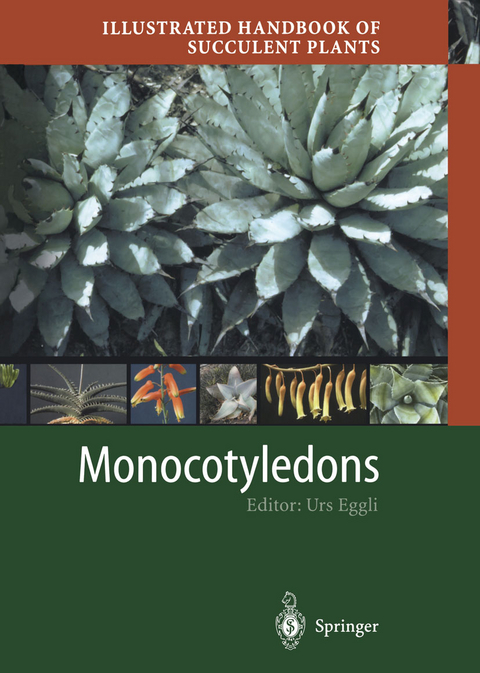
Illustrated Handbook of Succulent Plants: Monocotyledons
Springer Berlin (Verlag)
978-3-642-62585-5 (ISBN)
- Titel erscheint in neuer Auflage
- Artikel merken
What is a Succulent?.- How to Use This Handbook.- Scope of Information Presented.- Agavaceae ?.- Agave ? (221/50).- Beschorneria ? (7/1).- Furcraea ? (21/1).- Hesperaloe ? (5/1).- Hesperoyucca ? (1/0).- Yucca ? 47/12).- Aloaceae ?.- ?Algastoloba ~.- Aloe ? (446/57).- ?Alolirion ~.- ?Aloloba ~.- ?Alworthia ~.- Astroloba (6/0).- ?Astroworthia ? (1/0).- ?Bayerara ~.- Chortolirion ? (1/0).- ?Cummingara ~.- ?Gasteraloe ? (18/3).- ?Gasterhaworthia ~.- Gasteria ? (17/9).- ?Gastroloba ~.- Haworthia ? (62/105).- ?Maysara ~.- ?Poellneria ~.- Poellnitzia ? (1/0).- Amaryllidaceae ?.- Boophane ? (2/0).- Brunsvigia ? (2/0).- Cyrtanthus ? (4/0).- Haemanthus ? (3/0).- Rauhia ? (3/0).- Anthericaceae ?.- Chlorophytum ? (2/0).- Araceae ?.- Zamioculcas ? (1/0).- Asparagaceae ?.- Myrsiphyllum ? (3/0).- Asphodelaceae ?.- Bulbine ? (70/1).- Trachyandra ? (5/0).- Bromeliaceae ~.- Commelinaceae ?.- Aneilema ? (1/0).- Callisia ? (8/0).- Cyanotis ? (3/0).- Tradescantia ? (8/0).- Tripogandra ? (4/0).- Dioscoreaceae ?.- Dioscorea ? (6/4).- Doryanthaceae ?.- Doryanthes ? (2/0).- Dracaenaceae ?.- Cordyline ? (1/0).- Dracaena ? (7/1).- Sansevieria ? (61 /9).- Eriospermaceae ?.- Eriospermum ? (4/0).- Hyacinthaceae ?.- Albuca ? (5/0).- Bowiea ? (2/0).- Dipcadi ? (1/0).- Drimia ? (3/0).- Hyacinthus ? (1/0).- Lachenalia ? (1/0).- Ledebouria ? (3/0).- Litanthus ? (1/0).- Massonia ? (1/0).- Ornithogalum ? (10/0).- Rhadamanthus ? (8/0).- Rhodocodon ? (1/0).- Schizobasis ? (2/0).- Urginea ? (4/0).- Whiteheadia ? (1/0).- Nolinaceae ?.- Beaucarnea ? (8/0).- Calibanus ? (1/0).- Dasylirion ? (7/1).- Nolina ? (7/0).- Orchidaceae ~.- Xanthorrhoeaceae ~.- References.-Taxonomic Cross-Reference Index.
From the reviews of the first edition:
"This series is a reference manual for taxonomists and horticultural cognoscenti. It compiles up-to-date information not readily available from other sources ... . This series is invaluable to identify succulents, by either picture keying ... or by formal text keying. ... The volumes are well produced. ... this is an excellent series, a significant contribution to the literature, and a superb production. ... This fine series is a boon to all aficionados of succulents ... ." (Rudolf Schmid, Taxon, Vol. 52, 2003)
"This 'Illustrated Handbook of Succulent Plants' ... presents the newest stand of knowledge in all aspects of this group of plants. ... the cross reference index is very helpful. ... this comprehensive taxonomic work updating the increased knowledge of succulents in 20 years is well suited and highly recommended to all plant scientists, including herbarium staff, and horticulturists, and to the wide range of fascinated hobbyists. ... this volume will find a very wide readership ... ." (Norbert Leist, Journal of Plant Physiology, Vol. 159 (7), 2002)
"Here is the first volume of the new Illustrated Handbook of Succulent Plants ... . My first impression with the book in my hand was of pleasure. It is very well produced, accurately bound, with an excellent cover design. ... No doubt that such a work is particularly useful to the botanist and the scholar, as well as to the serious collector. But I have no hesitation to state that any succulent plant lover should find a place for it in his library ... ." (L. Russo, Botanybooks, September, 2001)
"We are promised a total of six volumes on ... succulents under the title of the Illustrated Handbook of Succulent Plants. ... The first of these volumes to appear is the one on monocotyledons. ... this is an excellent introduction to the plant groups covered and as a rigorous compilation of both diagnostic and bibliographic information iswithout peers. ... It is essential for the committed collector of succulent plants and mandatory for libraries of plant societies, herbaria and botanic gardens." (Paul I. Forster, Plant Systematics and Evolution, Vol. 229 (1-2), 2001)
| Erscheint lt. Verlag | 21.10.2012 |
|---|---|
| Reihe/Serie | Illustrated Handbook of Succulent Plants |
| Mitarbeit |
Assistent: S. Arroyo-Leuenberger, M.B. Bayer, J. Bogner, U. Eggli, P.I. Forster, D.R. Hunt, E.J.Van Jaarsveld, N.L. Meyer, L.E. Newton, G.D. Rowley, G.F. Smith, J. Thiede, C.C. Walker |
| Zusatzinfo | XIV, 354 p. 32 illus. in color. |
| Verlagsort | Berlin |
| Sprache | englisch |
| Maße | 193 x 270 mm |
| Gewicht | 871 g |
| Themenwelt | Naturwissenschaften ► Biologie ► Botanik |
| Naturwissenschaften ► Biologie ► Ökologie / Naturschutz | |
| Schlagworte | Amaryllidaceae • Desert plants • Ecology • Ericaceae • Herbar • monocotyledons • Orchidaceae • plant systematics • succulent plants • succulents • xerophytic adaptation |
| ISBN-10 | 3-642-62585-1 / 3642625851 |
| ISBN-13 | 978-3-642-62585-5 / 9783642625855 |
| Zustand | Neuware |
| Informationen gemäß Produktsicherheitsverordnung (GPSR) | |
| Haben Sie eine Frage zum Produkt? |
aus dem Bereich



